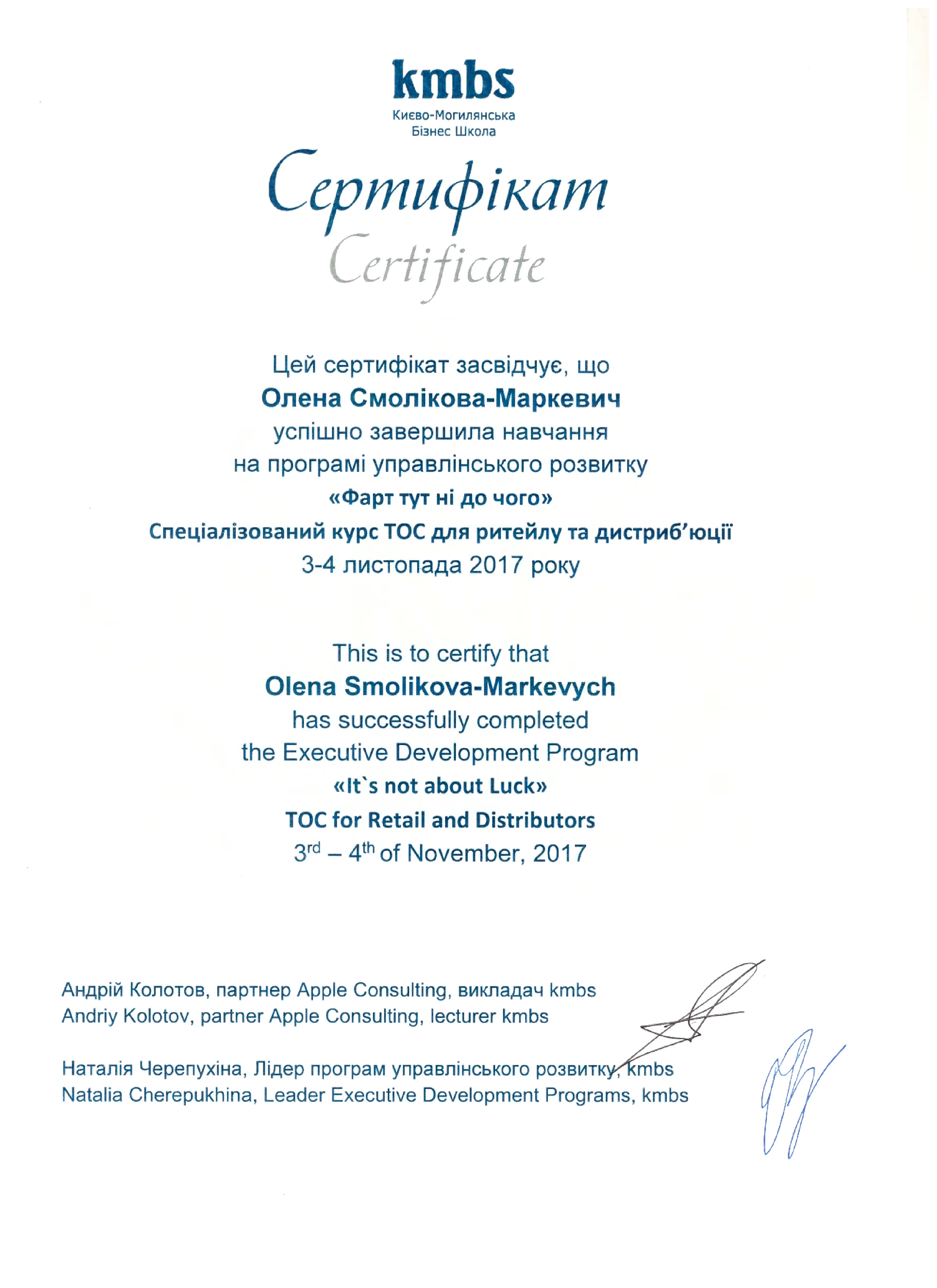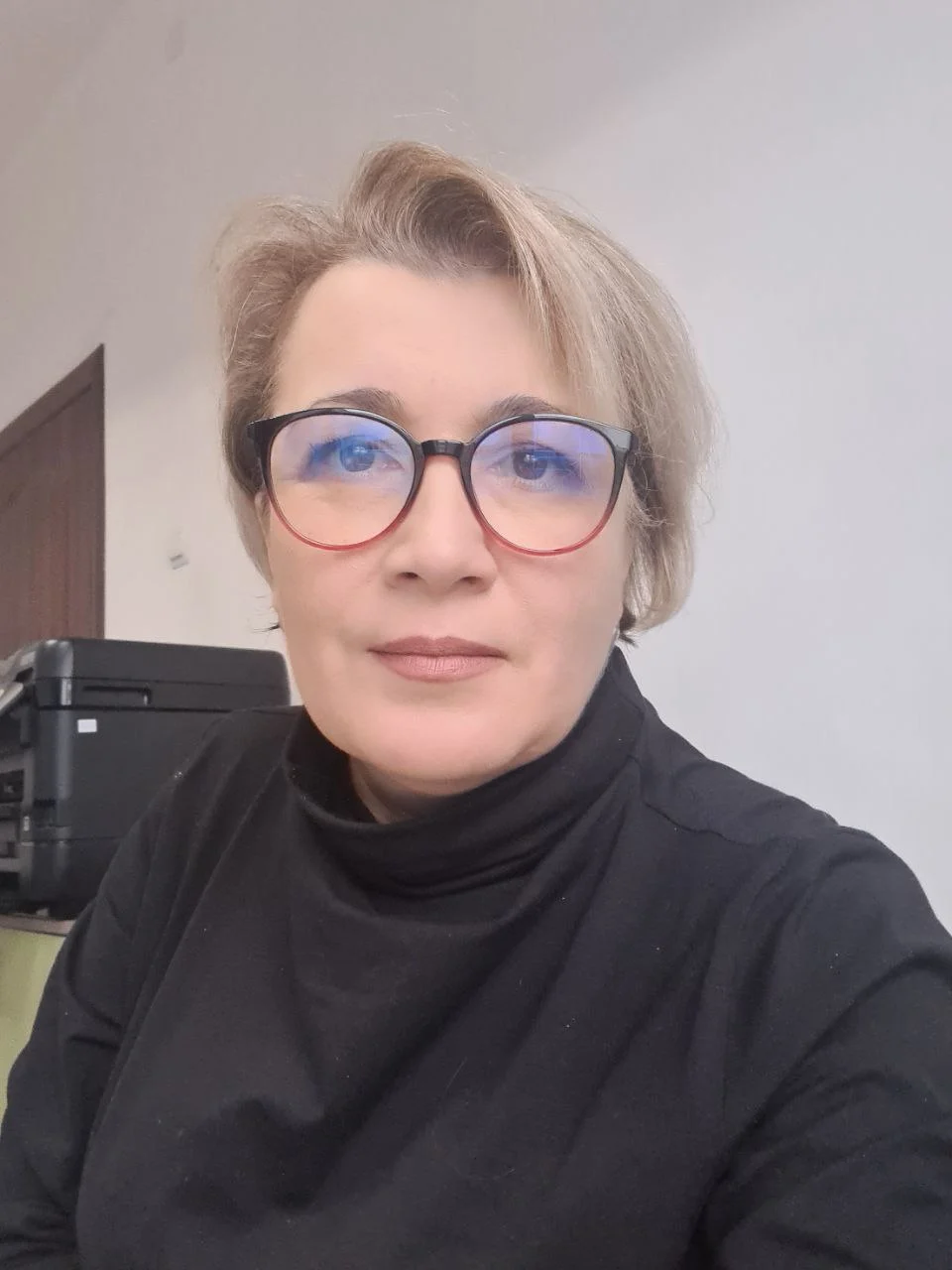Author's Posts

How Finmap enables businesses working with multiple contractors to gain full control over their finances
A practical, one-page guide to how Finmap helps businesses working with many contractors bring all finances into one system, forecast cash flow, control receivables/payables, and turn data into confident, proactive decisions.
As a business grows, financial flows become more complex—and along with them grows the number of people and companies with whom you need to negotiate, coordinate, make payments, or await payment.
Everything looks orderly—until one delay, one missed invoice, or a mismatch in payment dates triggers a domino effect.
The true financial strength of a business lies not only in profitability, but also in the ability to forecast, analyze, and act in advance.
Let’s look at three key elements that enable a business to maintain stability and grow without chaos.
1. Systematic approach: the first step toward financial maturity in business
If your business works with dozens of counterparties—contractors, clients, partners, suppliers—finances quickly turn into a mosaic.
Invoices in messengers, acts in email, payments across different banks, and information about debts—in a notebook or in a manager’s head.
As a result, it becomes difficult to answer even the basic questions:
- Who owes whom?
- What payments are expected?
- How much money will actually remain after all obligations?
Without a single system, data gets lost, and decisions are made blindly. Even a profitable business can end up in a cash gap simply because of the lack of a complete picture.
Here’s what it looks like in practice:
- Scattered data — information about payments, debts, and income is spread across different sources.
- Invisible obligations — there is no clear date of when and to whom payments should be made or expected.
- Loss of control — income is coming in, but there’s still not enough money because of chaotic payouts.
- Decisions “by guesswork” — made without analytics, without a clear connection between contractors, clients, and projects.
Systematicity is when all financial data comes together in a single reliable system: you see incomes, expenses, and debts all in one place.
Assess the level of systematization in your business
If most of the answers are “no,” it’s a clear signal that your financial system is not yet functioning as a single whole.
True systematization means having your money, obligations, and analytics gathered in one place — not scattered across different documents and spreadsheets.
5 steps to systematization with Finmap
To stop your finances from being just a set of fragmented data, you need a clear structure.
Finmap provides tools that bring all processes into a single system—from recording payments to controlling balances and forecasting cash flow.
- Collect all accounts in one place. Add contractors, clients, and bank accounts to Finmap to see all income and expenses in one centralized view.
- Record every payment and obligation. Create transactions right after an agreement or receiving an invoice—so nothing gets lost between emails and chats. Use the mobile app when you’re away from the office.
- Connect banks and cards. Synchronize your financial sources so that balances update automatically, and reconciliations take minutes instead of hours.
- Tag counterparties and projects. Link every payment to a specific contractor or client—this provides a transparent history of settlements and profitability for each direction.
- Plan ahead. Use the payment calendar and cash flow forecast to understand when funds are needed and how to avoid cash gaps.
Note: once a business becomes systematic, chaos stops draining energy—and that energy turns into growth.
2. Predictability: from financial chaos to a manageable, foreseeable system
In a business with many clients, contractors, and suppliers, money is constantly in motion.
Some inflows are still pending, other invoices already need to be paid, and in between are dozens of small transactions that create financial noise.
Of course, you can operate without a forecast, but there will be no stability in such a mode: risks will keep increasing.
Why predictability is critically important for business
- Ensures liquidity control. Allows you to assess whether there are enough funds to meet obligations, when cash gaps may occur, and how to prevent them.
- Increases financial stability. A business with a forecast does not depend on random inflows—it prepares in advance for peak loads and seasonal fluctuations.
- Reduces risks and financial stress. When planned payments and receipts are known, management decisions are made with a cool head—without haste or panic.
- Improves relationships with partners, clients, and contractors. Timely payments build the reputation of a reliable company and strengthen trust in cooperation.
- Enables strategic growth planning. Predictability shows when it is safe to invest, expand the team, or launch new directions without the risk of cash shortages.
What distinguishes chaos from a controlled financial system
Finmap is a tool that enables businesses to forecast their financial results.
Forecasting is only possible when the system shows not just numbers, but the link between income, expenses, liabilities, and future cash flows.
Finmap is built precisely for this—to give a business a complete picture of its finances and make management predictable.
It combines management accounting tools that let you see not only what has already happened, but also what comes next.
1. Planned payments and the Payment Calendar
In Finmap, you can plan both income and expenses, allowing you to record all future financial events before they occur.
All scheduled transactions automatically appear in the Payment Calendar, which builds a day-by-day forecast of your financial situation.
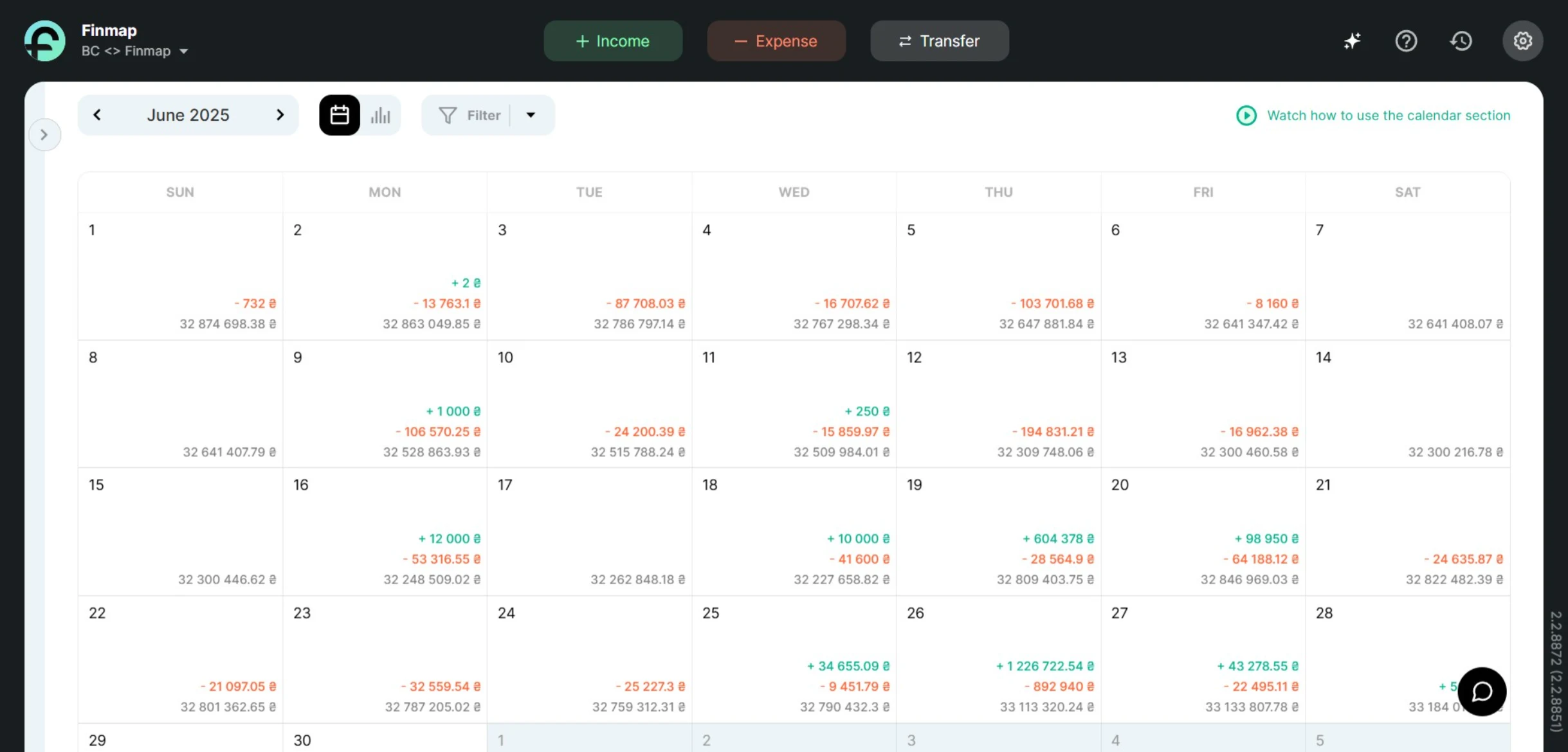
The more planned payments you enter, the more accurate the forecast becomes.
The calendar shows:
- which inflows and outflows are expected on a specific date;
- what the balance will be on the accounts after each transaction;
- whether there are enough funds on individual accounts for upcoming payments.
This tool helps identify cash gaps in advance and timely adjust financial flows.
A cash gap is not a sign of unprofitability; it’s an indicator of a lack of system in your finances.
The Payment Calendar in Finmap makes financial processes predictable and helps prevent situations where money suddenly falls short.
2. Accounts Receivable Report
The Accounts Receivable report in Finmap shows all funds that are due to the company from clients, partners, or contractors.
It’s not just a list of unpaid invoices, but a dynamic tool for controlling receivables that lets you see the financial situation in advance.
In Finmap you can see:
- who owes the company and how much;
- the expected payment date;
- the amount of overdue debts and their share of the total;
- the overall forecast of future inflows.
These data let you assess when exactly the company will receive money and whether it will be sufficient to meet current obligations.
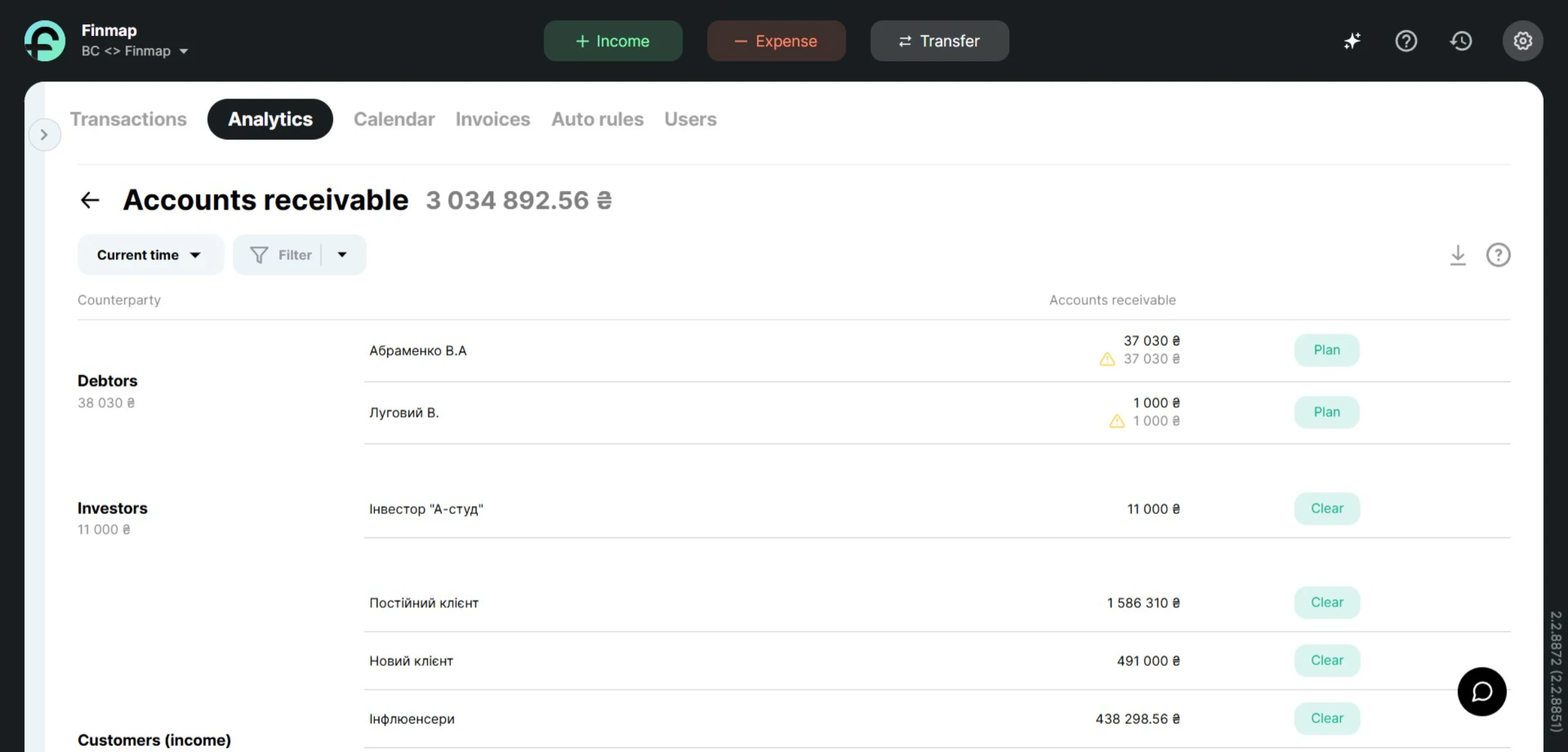
With this report, you can timely remind clients about payments, avoid delays, and make more accurate cash flow forecasts.
“Accounts Receivable” is your control tool that ensures stability and predictability of inflows, turning financial chaos into a clear system of settlements.
3. Accounts Payable Report
The Accounts Payable report in Finmap shows all the company’s obligations to contractors, suppliers, and partners.
It is a tool that lets you see to whom, when, and how much needs to be paid in order to avoid unexpected expenses and delays.
The report shows:
- a list of all upcoming and current payments;
- the dates on which payments are scheduled;
- the total amount of liabilities and their breakdown by counterparties;
- overdue payments that require attention.
Thanks to Accounts Payable, you can clearly control the company’s financial obligations, schedule payments on time, and ensure sufficient balances on accounts.
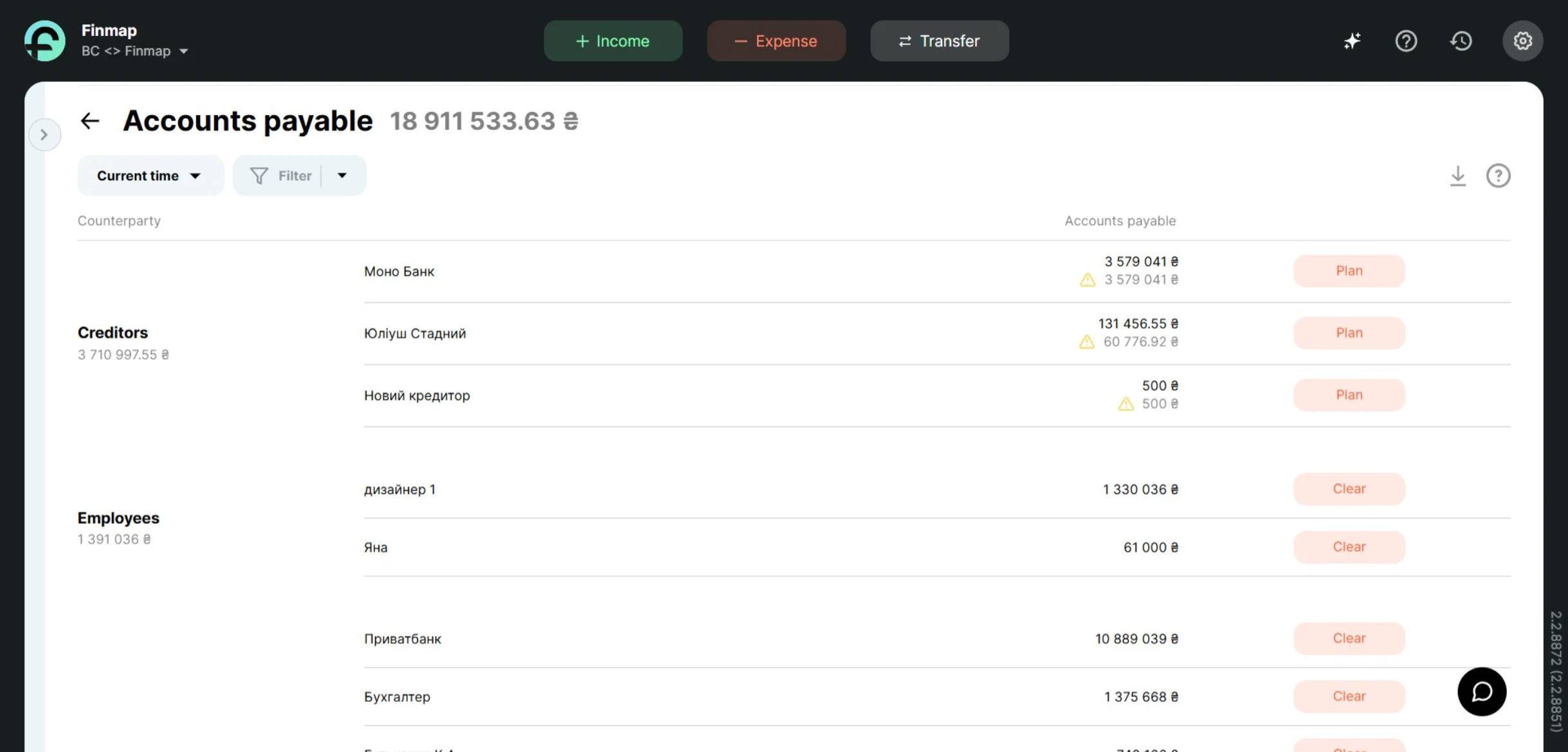
This helps avoid cash gaps, improves payment discipline, and builds the company’s reputation as a reliable partner.
The Accounts Payable report in Finmap is not just a list of debts but a financial forecasting tool that helps keep every hryvnia the company owes under control.
3. Analytics: when numbers turn into decisions
True financial management begins where analytics appears.
You can have systematization and even forecasting, but without an analytical view, a business doesn’t understand the main thing — why money comes in or disappears and what processes stand behind these changes.
Analytics is the ability to see not only the movement of money but also the meaning behind every number: which directions bring the most profit, which projects operate at a loss, which contractors or clients are the most efficient, and where expenses consistently exceed income.
Without analytics, financial accounting remains reactive — it only records facts. With analytics, it becomes a management tool that reveals connections, trends, and real results.
It is analytics that enables you to:
- measure business performance by numbers, not gut feeling;
- see the causes of financial fluctuations and respond in time;
- make strategic decisions based on data;
- optimize costs and increase profitability;
- plan growth using concrete metrics rather than intuition.
Finmap Reporting System: a complete picture of the company’s finances
Analytics in Finmap is not a separate tool but a system of reports that provide a full picture of the company’s financial state.
They show how different areas of the business operate and help evaluate profitability, efficiency, and the stability of financial processes.
Reports help you understand where the business earns and where it loses, and what decisions need to be made to improve the results.
For companies with many contractors, this is the key to effective management: every number has context, every payment has a reason, and every decision is based on data — not intuition.
How a business changes when finances are under control
Financial stability isn’t a coincidence—it’s the result of discipline, transparency, and understanding your own numbers.
Finmap helps shorten this path—turning data into confident decisions so the business grows without chaos.
Results of implementing a modern financial system
Finmap is not just a service, but a financial assistant that helps your business think systematically, plan ahead, and see real results in the numbers.
Take the next step — try Finmap and see how finances turn from a challenge into your advantage!
Frequently Asked Questions
1. How to understand that your business already lacks financial structure?
If reports don’t match reality, invoices get lost between channels, and there’s no clear answer to “how much money will remain after payments,” it’s a sign that your financial system operates chaotically.
2. Why can a profitable business still face cash gaps?
A cash gap doesn’t occur because of losses but because of timing mismatches between inflows and payments. The main cause is the lack of forecasting and obligation control.
3. How does financial forecasting help avoid risks?
Forecasting lets you see in advance when inflows and expenses are expected and prepare for periods of lower balances. This reduces the risk of delays and unexpected cash shortages.
4. Which reports should be analyzed to evaluate business performance?
The main ones are: cash flow (Cash Flow), profit and loss (P&L), debts, balance sheet, and plan–fact comparison. Together, they give a full picture of your financial state.
5. How to build a system that gives a real financial picture of your business?
Start with a single environment where all income, expenses, and obligations are recorded. Add regular report analysis and future payment planning — this will create the foundation for stability and predictability.
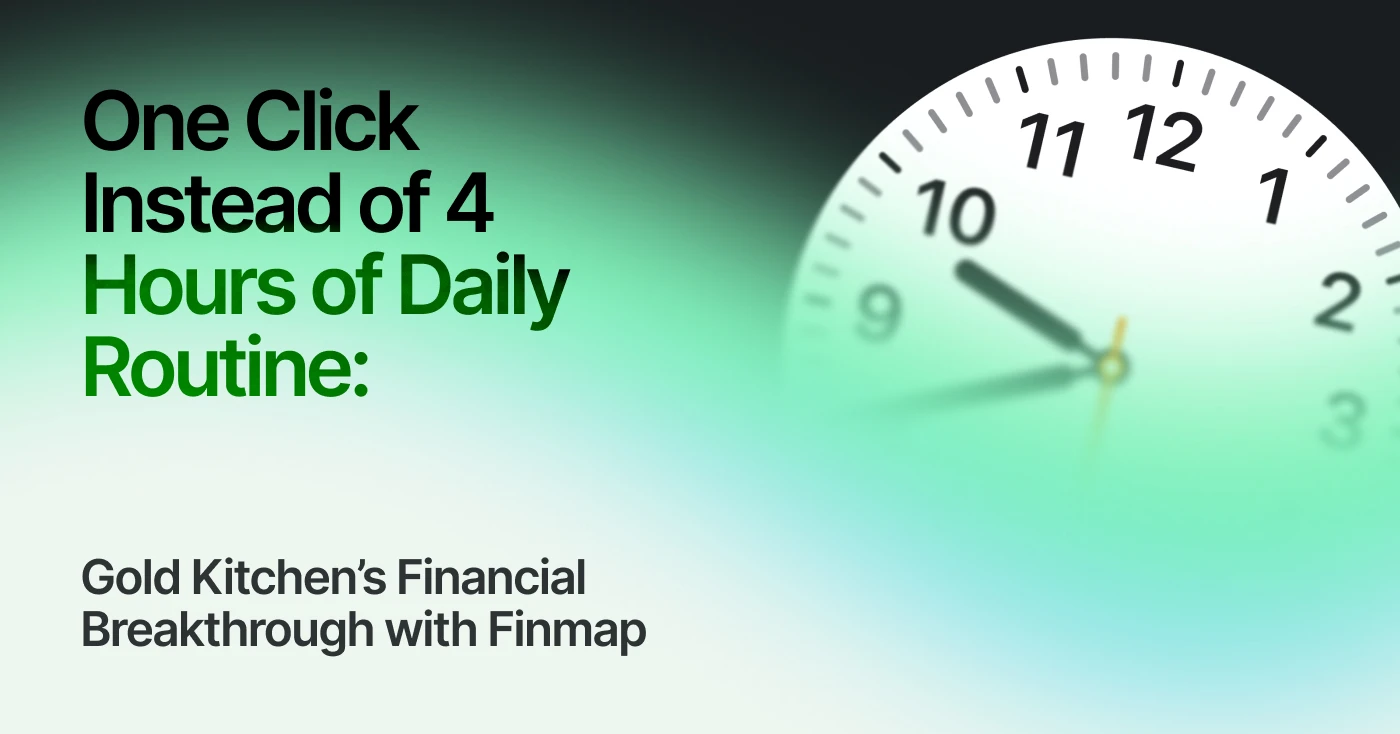
One Click Instead of 4 Hours of Routine Every Day: Gold Kitchen's Financial Breakthrough with Finmap
Instead of hours generating reports, you get full transparency of your business finances in seconds. How Finmap helped Gold Kitchen save time and money.
Imagine: you run a business selling goods in several areas — wholesale, retail, online orders. Every day, dozens of payments come in from customers, transfers go out to suppliers, salaries are paid to the team, and expenses are incurred for advertising and logistics. And all this happens simultaneously.
Instead of a clear picture of your finances, you have chaotic spreadsheets and endless banking apps. Roman, owner of Gold Kitchen, a company that sells professional equipment for HoReCa, spent several hours every day manually adding up numbers to understand what was happening with his money.
I spent four hours a day just reviewing and "dragging" funds from one month to another. — Roman, owner of Gold Kitchen
This is not just a routine — it is time that could have been spent on development: launching new directions, working with clients, scaling. But instead, the business lived "on feelings":
- it was unclear which sales direction was more profitable;
- financial flows were fragmented;
- decisions were made without data, "by eye".
This was the daily reality of a company that had outgrown its small business status and required a systematic approach.
Everything changed when Roman decided to get out of this financial chaos: he connected Finmap and, together with an experienced financial expert, built a management accounting system that gave him a clear picture of all areas of the business.
In this article, you will learn:
- how Roman transformed chaotic accounting into a systematic financial model;
- how Finmap saved hours of manual work;
- what insights he gained and how it influenced his business decisions.
Read on to see how transparent finances can become a growth point for your business.

About the Client and His Business
Roman is a Ukrainian entrepreneur who develops a business in the field of goods sales. His company operates in several areas:
- retail sales;
- online orders;
- wholesale deliveries to partners.
This is not a start-up or a hobby — it is already a business with a team of employees and stable turnover. The work format is completely remote, because after 2019, the company gave up its office, and this creates additional challenges: financial control must be carried out in such a way that each participant in the process has access to up-to-date information in real time.
Features of Roman's Business
- Several sales channels — it is important to see which one brings the most profit.
- Various sources of income — bank transfers, cash, online payments.
- Many transactions every day — dozens of payments from customers and suppliers.
- Team — several employees who work remotely and need transparent processes.
Why It Matters
When a business grows, it is the speed and transparency of financial accounting that determine whether it can scale further. In Roman's case, there was no management accounting at all, and decisions about expenses and investments were made based on intuition.
I didn't know what my turnover was or which areas were profitable. I just had a rough idea of the figures. — Roman, owner of Gold Kitchen
This meant that:
- the owner did not see the real picture for each area of the business,
- he spent hours manually compiling data from various banks and Excel spreadsheets,
- could not predict cash gaps and plan payments.
Financial Problems and the Turning Point
The growth of Roman's business brought not only higher turnover but also serious financial challenges. The more customers and sales areas appeared, the more chaos arose "behind the scenes."
The problem was that there was simply no financial accounting. — Roman, owner of Gold Kitchen
Main Financial Difficulties
The Turning Point
The culmination was that the business began to grow faster than the owner could control the finances.
This point is growth, i.e., an increase in financial burden. Finances force you to turn to specialists like you. — Roman, owner of Gold Kitchen
Every day spent on manual operations was a day when the business did not move forward. It was then that Roman realized he needed a system that would collect all the data in one place, automate routine tasks, and allow him to see the financial picture of the business at any moment.
Implementing Finmap and Working With a Financial Expert
To overcome the chaos, Roman decided to take a systematic approach. He connected Finmap and invited a financial expert with over 20 years of experience working in large companies and importers. It was a turning point: instead of trying to figure things out on his own, the business received a professional approach to implementing management accounting.
The financial expert is top-notch. I am very pleasantly surprised. Knowledge is key. — Roman, owner of Gold Kitchen
How the Implementation Took Place
- Analysis of financial flows — the expert helped describe all sources of income and expenses and divide them by area.
- Finmap configuration — the system was adapted to the specifics of the business: categories were created for each area, and rules were set for automatic accounting.
- Data synchronization — integrations where possible and file imports where automation is not available.
- Training the owner and team — so that Roman could quickly analyze data and make decisions without manual reports.
Challenges and Solutions
Why It Worked
- Expertise: the financial consultant didn't just set up the system, but explained how to use it for decision-making.
- Systematic approach: Finmap became the single system for all financial data.
- Speed: instead of hours of manual work, a few clicks are enough to see the real picture.
How the Business Changed After Implementing Finmap
After implementing Finmap and setting up processes, Roman's business made a leap forward in financial transparency. Instead of chaotic tables and manual reports, there is now a single accounting system that shows the financial picture in real time.
One second is a huge time saver; you can see all your finances at any time of the day or year. — Roman, owner of Gold Kitchen
Key Results
- The time spent on financial management has been reduced tenfold — instead of 4 hours a day, a few clicks are enough.
- Complete transparency — all income and expenses are visible, broken down by category.
- Clear analytics — you can evaluate the profitability of areas and see expenses down to the penny.
- Preparation for forecasting — a customized database for planning cash gaps and payments.
- Easier decision-making — the owner no longer relies on intuition but works with data.
The most valuable thing is the experience of how to solve a particular financial or accounting problem. — Roman, owner of Gold Kitchen
Roman emphasizes that the key to implementation was not only the system, but also the consultant's expertise, which helped to correctly distribute areas, set up processes, and teach the team to work with numbers.
The Current Situation and Plans for the Future
Today, Finmap has become the main tool for financial control of Roman's business.
The owner sees the current financial picture every day and spends a minimum of time on routine tasks.
I understood more clearly how much each month cost. Everything is shown here, down to the penny. — Roman, owner of Gold Kitchen
Current Status
- The basic model is set up — all income and expenses are divided into categories.
- Business areas are separated — now you can analyze which area brings the most profit.
- Single point of truth — all finances are collected in one place.
- The team is involved — some processes have been delegated, and the owner has freed up time for strategic decisions.
Plans for the Future
- Use Finmap's features to forecast cash flow gaps.
- Optimize expenses by area to increase margins.
- Use Finmap as a basis for strategic financial decisions.
- Scale the business by opening new sales channels with already established management accounting.
Insights for Entrepreneurs
This case study is not only about software implementation, but also about changing the mindset of the business owner.
Here are the main lessons to be learned:
- Management accounting is not a luxury, but a necessity during the growth stage.
- System + expert = quick results. Professional support reduces implementation time and minimizes errors.
- Transparency brings peace of mind. When you see data in real time, you can make decisions with confidence.
- The owner's time is the main resource. Automation frees up hours that can be invested in development.
Before, there was accounting that worked more for the state. After, there was management accounting that works for the company. — Roman, owner of Gold Kitchen
Roman's story: Chaos in finances is not a death sentence. It is a signal that the business has grown to a new level and needs systematization.
Finmap helped:
- bring all financial flows together in one place,
- free up time from manual work,
- see the big picture in each area,
- prepare the ground for scaling and strategic decisions.
Now we have more than just accounting for reports; we have management accounting that shows the real picture of the business. — Roman, owner of Gold Kitchen
Ready to get your finances in order? It's time to stop running your business based on gut feelings. Try Finmap for free and see how transparent finances can become a growth point for your business.
Frequently Asked Questions
1. Can I use Finmap on my own?
Yes, but the Gold Kitchen case study shows that working with a financial expert significantly speeds up the process. An expert helps you set up categories, divide business areas, and teach your team to work with data without errors.
2. What if the bank or service is not integrated?
Finmap supports file import. In the case of Gold Kitchen, this is how NovaPay was connected and accounting for Monobank accounts was set up. This allows you to see all transactions in one place even without direct integration.
3. How long does implementation take?
On average, a few weeks. It all depends on the number of accounts, business areas, and sources of income. After the initial setup, you can see the financial picture and save time on manual reporting.
4. Do I need to spend time updating the system?
Yes, Finmap, like any CRM, requires attention: you need to update data and control categories. But the benefits are enormous: the owner gets a complete picture of their finances in seconds, instead of spending hours on manual reporting.
.webp)
Business without chaos: 5 simple steps to growth
No matter what stage your business is at now, these 5 steps can be the start of a new quality of management.
In business, there’s no such thing as a perfect moment for change. But there are the right decisions — and they’re what separates those who grow from those who stay stuck.
Want this year to be a real breakthrough for your business? Then don’t wait for the perfect moment — act now.
This article gives you 5 proven steps to bring order, increase efficiency, and make a leap forward — without burnout or chaos.
1. Lay a Solid Foundation for a New Strategy
Before setting new goals, analyze what worked before. What parts of the previous plan were successfully implemented? What results actually impacted your business? And where were the losses, mistakes, or just illusions?
To do this properly — summarize the year: financially, operationally, strategically. We’ve put together a step-by-step guide on how to prepare and analyze reports — with examples and a detailed video.
Next step — involve your team. Run a brainstorming session: let everyone share their vision, problems, and ideas. This isn’t just “gathering opinions” — it’s a chance to see the business from different angles and get your people engaged in the shared result.
Don’t hold back on creativity — sometimes an unconventional idea becomes a breakthrough. The outcome will be an updated business plan based on data and your team’s real experience.
2. Free Your Business from Routine — Automate Processes
Daily repetitive tasks drain not just time, but energy. As a result, your team works on the edge while strategic goals keep getting postponed. Sound familiar?
Automation helps you regain control. What used to take hours can now be handled in a few clicks — or without your involvement at all. For example:
- Do clients often ask the same questions? Set up an AI bot.
- Struggling with complex payment and expense tracking? Enable automatic imports and reporting.
- Sending the same invoices every month? Turn on auto-generated invoicing.
Repetitive tasks are the first thing to delegate to a system.
This not only saves you time, but reduces the risk of errors. Most importantly, it creates space for business growth.

3. Make Marketing an Asset, Not an Expense
What worked a year ago might not deliver results today. Marketing changes faster than you can update your banners. That’s why it’s essential not to get stuck in the past — test new approaches, experiment, and stay alert.
Here are a few directions worth considering right now:
- AI in Action
Chatbots? Sure. But not just that. AI helps write content, tailor ads to user behavior, and even predict what will work. The sooner you adopt it — the bigger your advantage.
- Interactivity is the New Standard
Simple videos aren’t enough anymore. Engage your customer: quizzes, polls, calculators, gamification. This isn’t entertainment — it’s experience-driven selling.
- Being Honest = Being Strong
Brands that speak about their values attract people. Supporting volunteers, planting trees, helping the Armed Forces? Don’t stay silent. Just make sure your actions are real — not for show.
- User-Generated Content (UGC)
Photos with your product, social media stories, honest reviews — these signals are stronger than any marketing slogan. Create the conditions for people to want to share their experience.
- Brand Voice = Your Advantage
Tone, language, and style of communication are part of your competitive edge. If your brand sounds sincere and human — it’ll be remembered.
- Micro-Influencers + Local Thought Leaders
You don’t always need to go after big names. Local bloggers and micro-influencers have deeper engagement with their audience. Work with those who truly earn trust in your niche or region — you’ll be surprised by the results.
Don’t chase every trend — pick the ones that work for your business. But whatever you do, don’t ignore change. Marketing that doesn’t evolve quickly becomes just another sunk cost.
4. Expand Your Service Line Strategically
Adding new products or services is one of the most effective ways to scale a business. If done at the right time and with market needs in mind, it brings several benefits:
- Attracting new clients — a broader offer opens doors to a new audience.
- Increasing the average check — existing clients buy more when they have options.
- Boosting loyalty — when your business grows alongside the client and offers them new value, it builds trust.
- Gaining a competitive edge — you stand out not just with price, but with a comprehensive approach.
- Diversifying risk — less reliance on a single revenue stream = greater stability.
But expansion only makes sense if it’s thoughtful.
Start with analysis: which needs remain unmet? Is there demand? What’s the potential margin?
Write out a strategy: who the service is for, how it fits into the business model, what team and resources it requires. Only then — move to implementation.
Strategic scaling is not about quantity of services but the quality of decisions behind them.
5. Money Doesn’t Like Guesswork — Implement Systematic Financial Management
A business can’t grow sustainably without transparent accounting. If you’re still making financial decisions by instinct or just checking your account balance — that’s not management, that’s guessing. And in the long run, it’s always risky.

Regular financial management helps identify weaknesses, avoid cash gaps, and make informed leadership decisions. Here’s how to start:
Step 1. Master the Basics of Managerial Accounting
Even if you have a bookkeeper or CFO, as a business owner you must understand the basics. This is crucial for strategic control:
- how managerial accounting is structured;
- what P&L, Cash Flow, and Balance Sheet are — and how to analyze them;
- how the cash method differs from accrual — and which is relevant for your business;
- how to plan expenses and revenue for the next month or quarter.
A common mistake is trying to manage finances manually in Excel. Formula errors, lack of a single responsible person, loss of data — all this leads to inaccuracies and losses.

Step 2. Automate Financial Processes
To save time, prevent errors, and get timely, accurate financial data — automate your accounting.
Finmap allows you to integrate bank accounts, so all incoming and outgoing transactions are synced automatically. But automation doesn’t stop there.
The next level is automatic processing rules (autorules): The system analyzes transaction comments and categorizes them by project, counterparty, direction, and so on.
This in turn generates up-to-date reports automatically — available to you anytime, anywhere.
Finmap AI Copilot: Smart Financial Management Support
At the final link of this automation chain is Finmap AI Copilot — an AI tool that not only shows numbers but turns them into decisions.
Finmap AI Copilot automatically generates a detailed report based on your financial data. In it, you get:
- key metrics in a convenient format;
- warnings about potential risks: from reduced profitability to cash gap danger;
- personalized recommendations: how to optimize expenses, improve cash flow, or adjust your financial model.
It’s your personal financial analyst that never takes a day off — and works based on your actual business data, not assumptions.
Step 3. Plan, Don’t Just Record
Your account balance isn’t your profit — and without factoring in upcoming obligations, it can give a false sense of stability.
To see the full picture — financial planning is essential.
This is where Finmap’s Payment Calendar helps — a tool that shifts your finances from reaction mode to proactive management.
Thanks to the payment calendar, you’ll be able to:
- forecast upcoming expenses and income;
- anticipate cash gaps in advance;
- build reserves for critical costs;
- understand how much you can realistically invest or withdraw;
- plan profit based on data, not just gut feeling;
- finally stop living “from transaction to transaction.”
The calendar bridges the gap between current balances and future obligations — giving you real control over your finances.
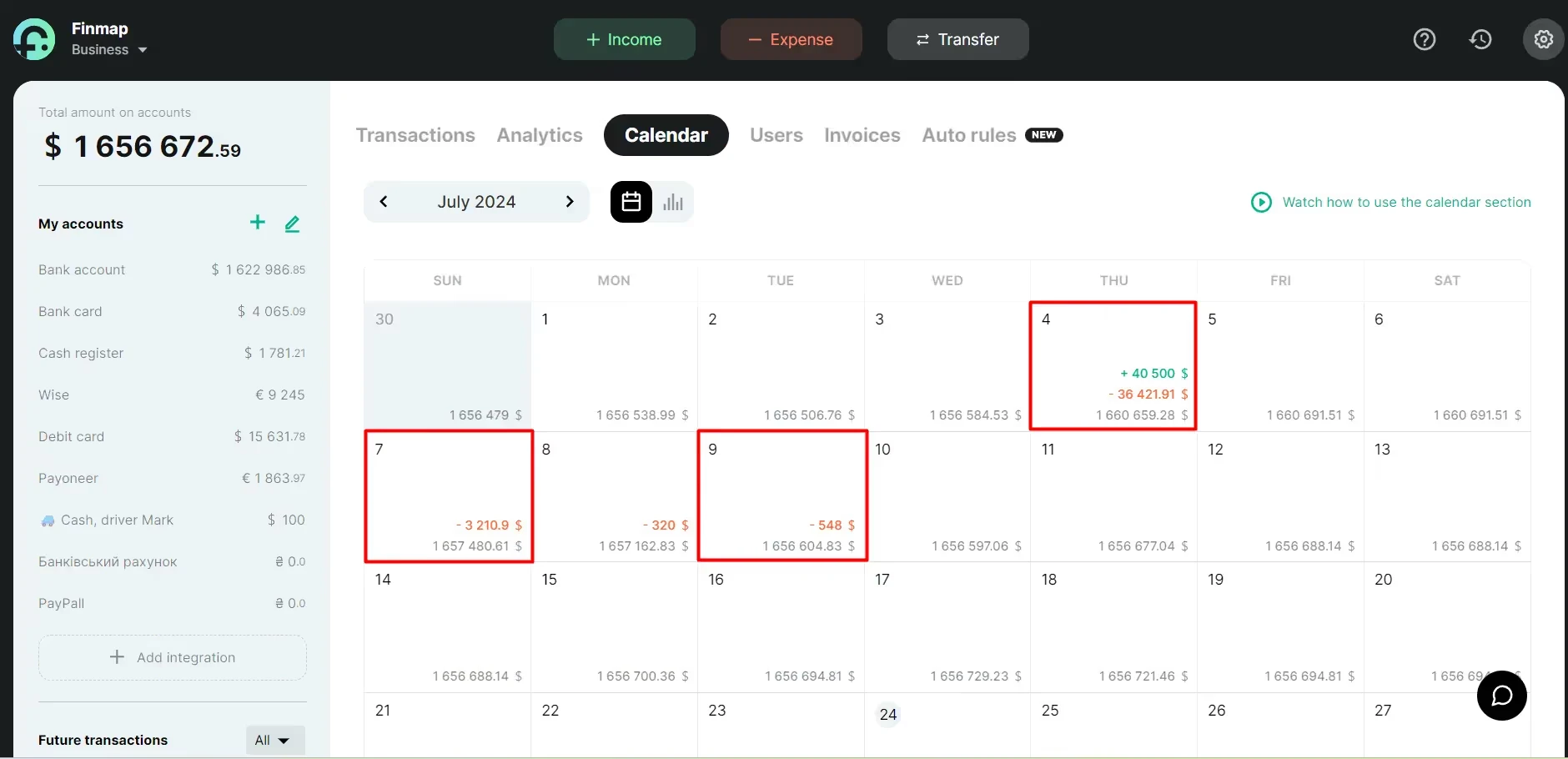
Efficiency isn’t a one-time leap — it’s systematic work on yourself, your team, and your processes.
The 5 steps you’ve just read can change your business’s financial resilience. But to turn these changes into reality — you need a tool that lets you manage your finances without chaos.
Finmap is managerial accounting, automation, planning, and AI analytics — all in one solution.
Start now — take control of your finances. Because that’s where stability and growth begin.
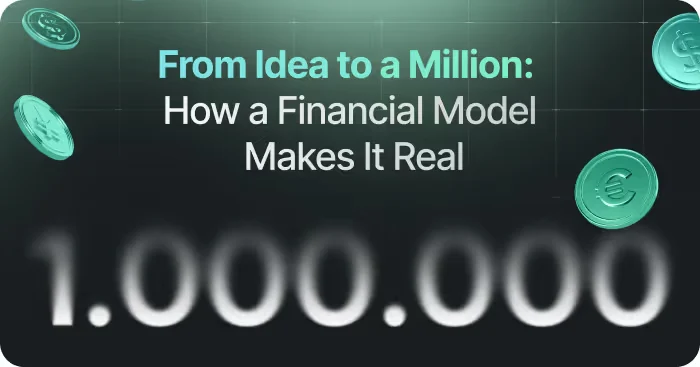
Financial Model as the Key to a Million: How to Make Your Idea Successful
From idea to million: how a financial model can make it happen. Learn strategies that turn concepts into successful businesses.
Do you want to start a business or double your growth? You probably have a hundred questions swirling in your head: how much money do you really need? When will you break even? And will you even break even at all? What if everything goes wrong — how much will you lose?
If you don't want your idea to drown in chaos, it needs structure and a clear financial justification.
A successful launch and scaling aren't about intuition. They're about a financial model that, even before launch, tells you: “yes,” “no,” or “not now.” Want to know how exactly? Let’s dive in.

What Is a Financial Model?
A financial model is a working tool that helps you forecast your future financial results based on key operational, marketing, and financial indicators.
This model allows you not just to “calculate expenses,” but to see the full picture: from revenue sources to cash flow, from margin to break-even point. And most importantly — it enables you to make informed decisions before you spend a single dollar.
Your Profit Model: Key Components
A financial model covers all key business processes in terms of numbers. Here are the main components:
- Basic parameters
These are the data points the entire model is built on: prices, sales volumes, salaries, taxes, advertising costs, etc. If you change these numbers — the whole model changes.
- Revenue forecast
This block shows where the money should come from: number of clients, conversion rate, average check, repeat purchases, and how revenue changes over time.
- Operating expenses
A clear expense structure helps calculate cost price more accurately, identify reserves, and define the break-even point. The financial model takes into account:
- Fixed costs — do not change with increased or decreased volume (e.g. rent);
- Variable costs — depend on production or sales volume (e.g. packaging, delivery);
- Direct costs — directly linked to production or service delivery;
- Indirect costs — support the business indirectly (administrative costs, marketing).
- Investments and depreciation
If the business buys something “serious” (equipment, machinery, large projects), these expenses are recorded separately and depreciated gradually.
- Taxes
Calculation of tax obligations depending on the taxation model, profit, and type of activity.
- Cash flow
The real money coming into and going out of the business. Even if you’re profitable — it doesn’t mean there’s money in your account. This block shows whether there’s enough cash to cover everything needed.
- Balance sheet
Assets, debts, inventory, capital — everything the business owns at a given moment. It provides insight into the company’s financial stability.
- Profit and loss statement
Shows how much the company earned (or lost) over a period. This is the main report for evaluating performance.
- Financial indicators
Break-even point, EBITDA, margins, liquidity ratios — everything that helps assess business efficiency.
Together, this isn’t just a “spreadsheet of numbers,” but a model that allows you to test ideas, see the consequences of decisions, and confidently plan the future.
Real Reasons to Have a Financial Model Before You Launch
A financial model is not just a “file for investors.” It’s your working tool for strategic thinking and real control over your situation. Here’s what it gives you:
- Strategic vision
The model helps you see not only where you are now, but also where you're headed. It helps anticipate potential threats, identify growth points, and adjust your course before it’s too late.
- Risk forecasting
With the model, you can evaluate multiple development scenarios: what happens if sales drop by 20%, whether there’s enough working capital during tough months, and how to respond to price changes.
- Efficiency and optimization
The financial model helps identify where costs can be reduced, which areas offer the highest profitability, and how to allocate resources more effectively.
- Competitive advantage
While competitors act blindly, you make decisions based on data. This gives you a tangible edge in speed, flexibility, and accuracy.
- Connection between all processes
The financial model shows how every decision affects the business as a whole: how price changes affect revenue, revenue affects taxes, and taxes impact cash flow. It reveals interconnections that are hard to track intuitively.
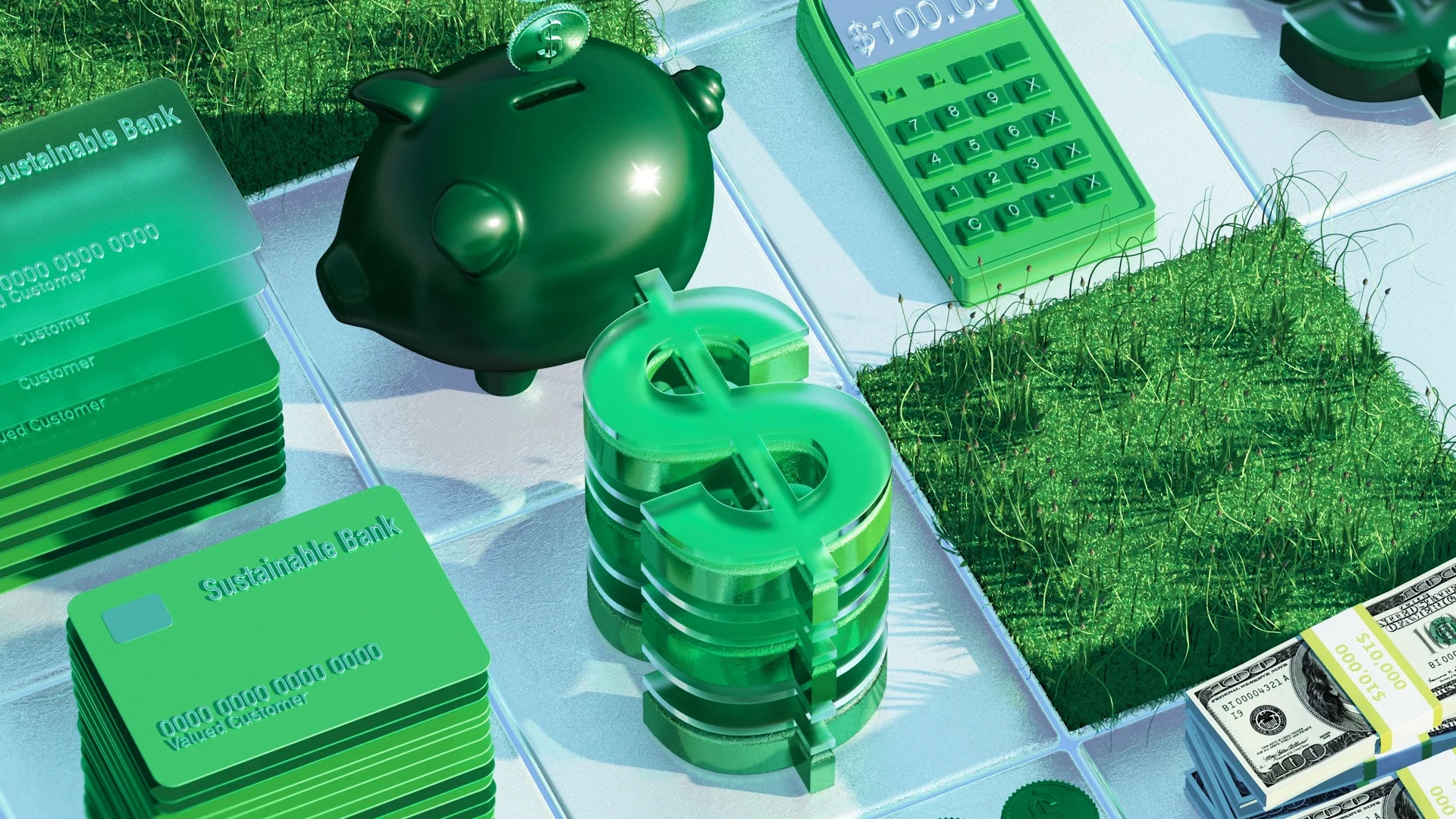
A Financial Model Isn’t Theory — It’s a Tool That Works in Practice
But how exactly does it help you make decisions, avoid mistakes, and plan a profitable launch?
To see it in action, it's worth looking at real examples. One such case is the EMMER company, which launched a new physical product to the U.S. market via Kickstarter.
It was a complex project involving international logistics, marketing, manufacturing, taxes, and influencer partnerships.
The financial model helped the entrepreneur:
- assess the realism of the fundraising goal;
- build several scenarios (optimistic, pessimistic, break-even);
- identify risks before the campaign even began;
- gather the data needed to make confident decisions.
Read the full Emmer case here → How Finmap creates financial models that ensure a successful launch
But this is just one scenario. A financial model allows for much more:
- Test hypotheses — for example, whether it makes sense to raise prices or launch additional services;
- Understand key impact points — which metrics affect profit the most and what actions truly make a difference;
- Avoid cash gaps — see when funds will fall short and adjust your plan in advance;
- Set realistic goals — instead of “I want a million,” understand how many clients and resources are truly needed to reach it;
- Calculate launch scenarios for a new direction or business — optimistic, realistic, and pessimistic, accounting for risks and resources;
- Determine if current resources are enough to achieve the goal — without relying solely on intuition;
- Accurately calculate how much you need to earn to recoup your investment — and whether it’s achievable at all;
- Evaluate whether your model allows you to earn as much as you want — before launching or scaling.
More real-life cases can be found in the carousel below.

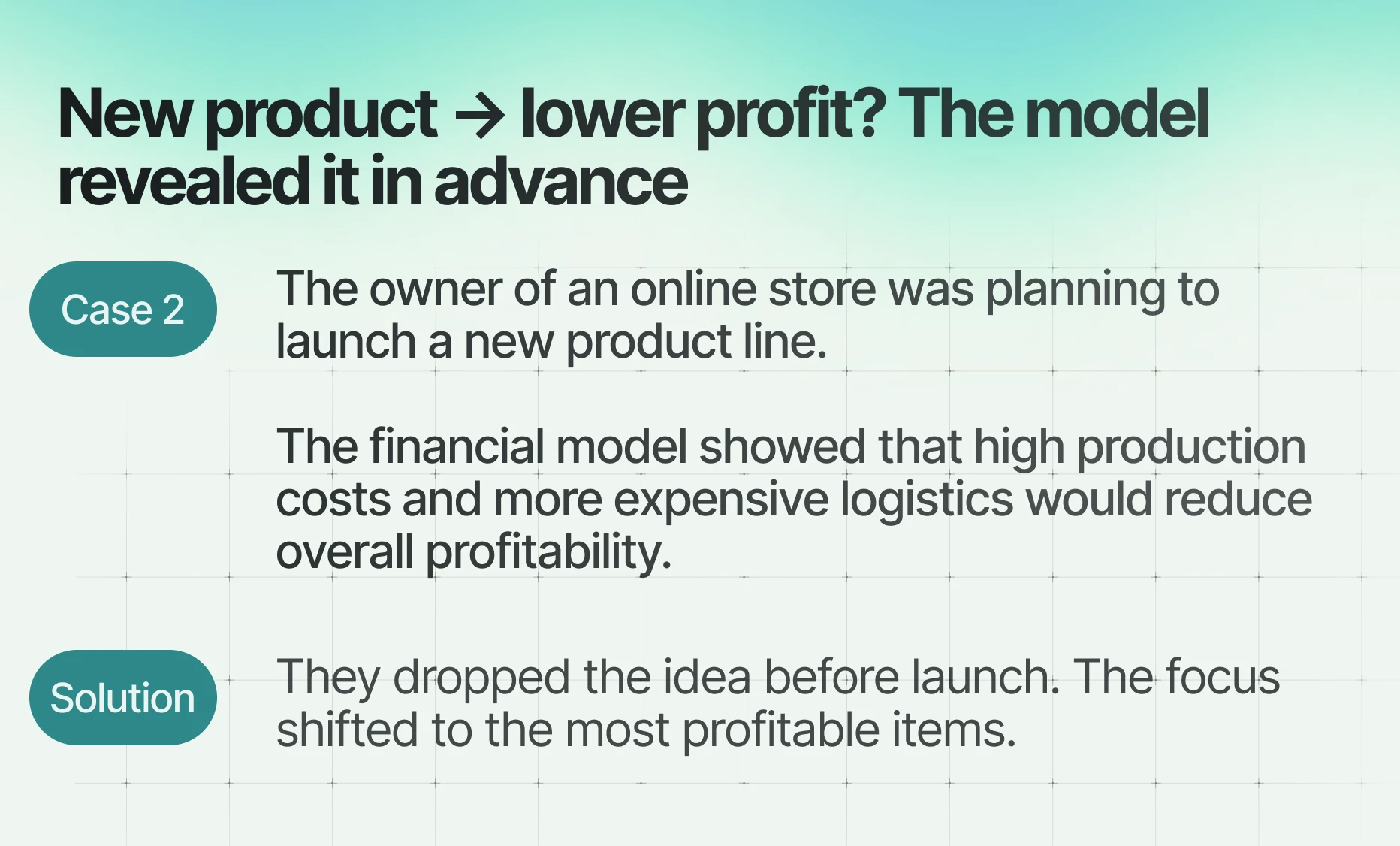

Strong Model = Strong Decision
A financial model is not just a section in a business plan — it’s your key tool for growth, decision-making, and maintaining control over your finances.
It gives you not just forecasts, but confidence in where you’re heading — and what to do if things go off track.
But building a solid model is more than just filling out an Excel sheet. It requires expertise, realistic assumptions, and experience working with different scenarios.
That’s why at Finmap, we help entrepreneurs:
- build a financial model tailored to their actual business — not just a “template”;
- calculate key scenarios, including risks and the break-even point;
- identify bottlenecks and growth opportunities;
- create a clear picture for themselves, partners, or investors.
Book a consultation with a Finmap expert — and we’ll create a financial model that works for you, not just for reporting.
Start managing your business by the numbers — not by guesswork!



-1.avif)

